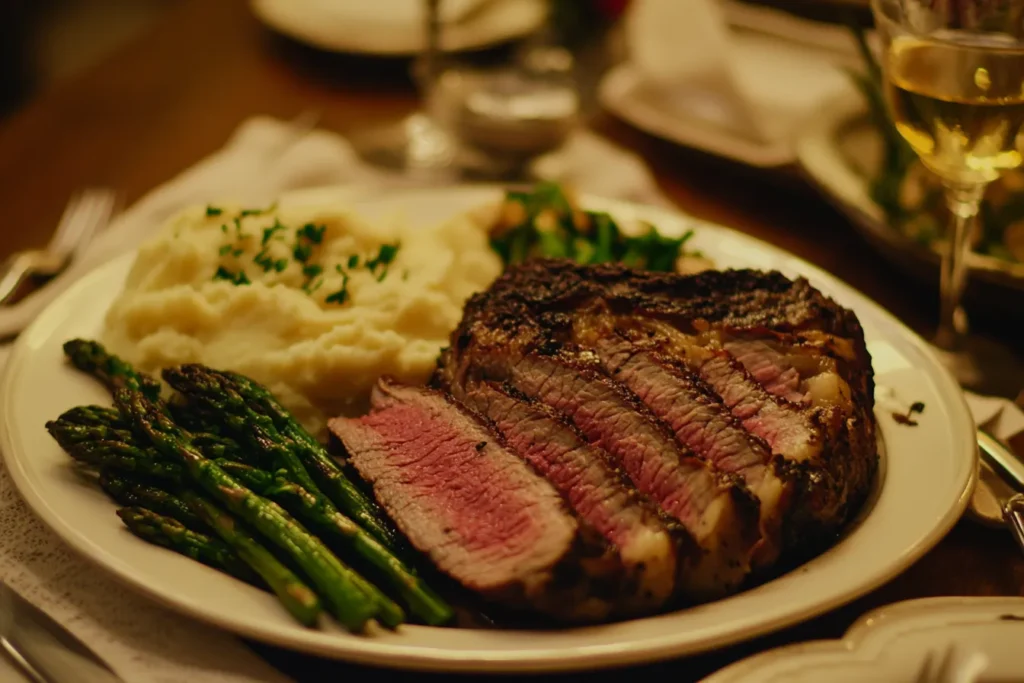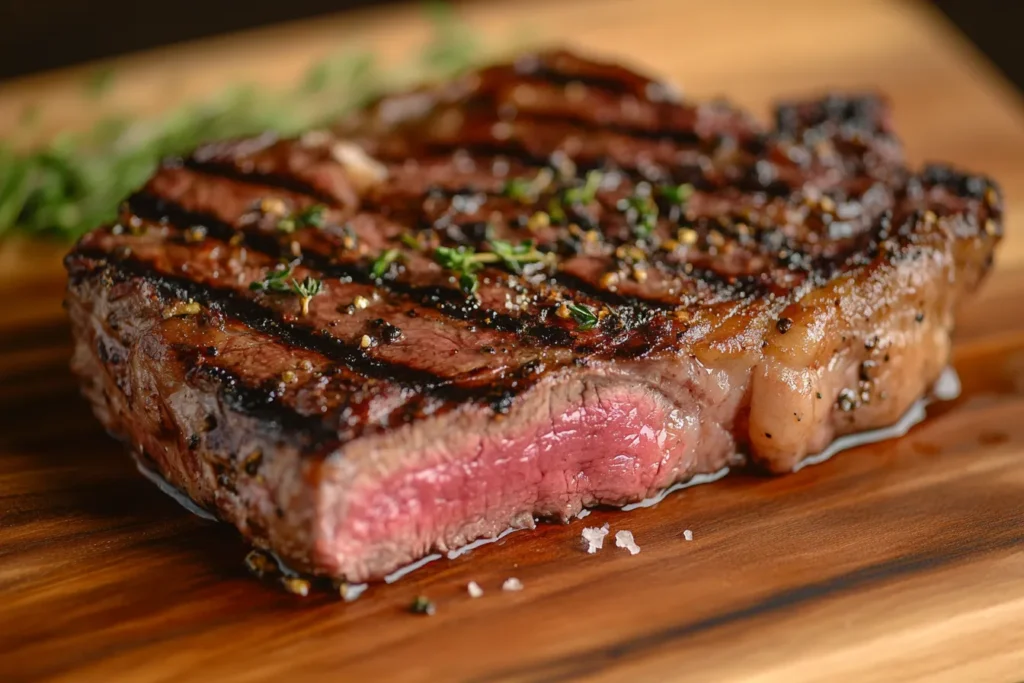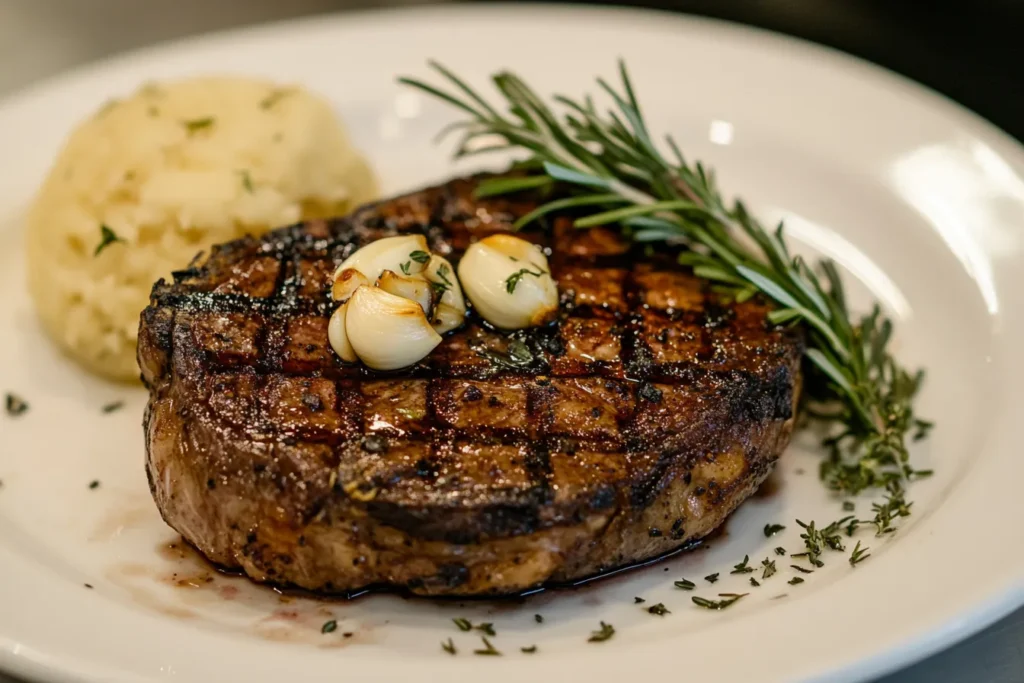Table of Contents
How is ribeye best cooked? This is a question that ignites passion among steak enthusiasts. The ribeye, known for its rich marbling and tender texture, deserves to be cooked to perfection. Whether you’re a seasoned chef or a home cook, understanding the nuances of ribeye preparation is crucial for achieving an unforgettable culinary experience.
Understanding the Ribeye Cut
Before diving into the cooking methods, let’s first understand what makes the ribeye so special. The ribeye comes from the rib section of the cow, specifically from ribs 6 through 12. Its generous marbling, the intramuscular fat, is what contributes to its flavor and tenderness.
The Importance of Marbling
Marbling is the key to a great ribeye. As the steak cooks, the fat melts, basting the meat from the inside out, resulting in a juicy and flavorful steak. Without adequate marbling, the ribeye can become tough and dry. Therefore, selecting a ribeye with ample marbling is paramount.
Bone-In vs. Boneless
Ribeyes are available both bone-in and boneless. Bone-in ribeyes, also known as cowboy steaks or rib steaks, often have more flavor due to the bone contributing to the cooking process. Boneless ribeyes are easier to handle and cook more evenly. The choice between the two is a matter of personal preference (How is ribeye best cooked?).
7 Incredible Secret Methods for Cooking Ribeye
Now, let’s explore 7 incredible secret methods for cooking ribeye to perfection, catering to various preferences and equipment. Each method offers a unique approach to unlocking the full potential of this magnificent cut of meat (How is ribeye best cooked?).
1. Reverse Sear: The Temperature Maverick
The reverse sear method involves slow-cooking the ribeye at a low temperature in the oven, followed by a quick sear in a hot pan. This method ensures even cooking throughout the steak and a beautiful crust (How is ribeye best cooked?).
- Process: Place the ribeye on a wire rack set inside a baking sheet. Bake at 250°F (121°C) until the internal temperature reaches 120°F (49°C) for medium-rare. Sear in a hot cast-iron skillet with oil or butter for about 1-2 minutes per side, until a golden-brown crust forms.
- Benefits: Even cooking, tender interior, perfect crust.

2. Cast-Iron Searing: The Timeless Classic
Cast-iron searing is a straightforward and reliable method for achieving a flavorful crust and juicy interior. The cast iron’s ability to retain heat ensures even cooking and a beautiful sear.
- Process: Heat a cast-iron skillet over high heat until smoking hot. Add oil with a high smoke point, such as canola or avocado oil. Sear the ribeye for 2-3 minutes per side, then reduce heat to medium and continue cooking to your desired doneness.
- Benefits: Excellent crust, consistent results, simple technique.
- Consider adding aromatics like garlic, thyme, and rosemary to the pan during the searing process for extra flavor (How is ribeye best cooked?).
3. Grill Master: The Smoky Sensation
Grilling imparts a smoky flavor to the ribeye that is hard to beat. Whether you’re using a gas or charcoal grill, mastering the art of grilling ribeye will elevate your cooking game.
- Process: Preheat your grill to high heat. Sear the ribeye for 2-3 minutes per side, then move it to a cooler part of the grill to finish cooking to your desired doneness. For a charcoal grill, create two heat zones: one for searing and one for indirect cooking.
- Benefits: Smoky flavor, char marks, outdoor cooking experience.
- Marinating the ribeye before grilling can add extra flavor and moisture.
4. Sous Vide Supreme: The Precision Approach
Sous vide involves cooking the ribeye in a water bath at a precise temperature. This method guarantees a perfectly cooked steak every time, with edge-to-edge doneness.
- Process: Season the ribeye and place it in a vacuum-sealed bag. Cook in a sous vide water bath at your desired temperature (e.g., 130°F (54°C) for medium-rare) for 1-2 hours. Remove from the bag, pat dry, and sear in a hot pan or on the grill for a quick crust.
- Benefits: Precise temperature control, consistent results, tender texture.

5. Broiling Brilliance: The Indoor Alternative
Broiling is a convenient indoor method for achieving a seared crust. It involves cooking the ribeye under direct heat from the broiler, similar to grilling.
- Process: Preheat your broiler to high. Place the ribeye on a broiler pan and broil for 4-5 minutes per side, or until your desired doneness is reached. Be sure to keep a close eye on the steak to prevent burning.
- Benefits: Quick cooking time, indoor convenience, seared crust.
- Position the ribeye closer or further from the broiler element to control the intensity of the heat (How is ribeye best cooked?).
6. Pan-Seared Perfection with Butter Basting: The Luxurious Treat
Pan-searing with butter basting takes the classic cast-iron sear to the next level. The addition of butter, aromatics, and frequent basting creates an incredibly flavorful and moist ribeye.
- Process: Heat a cast-iron skillet over high heat. Add oil and sear the ribeye for 2-3 minutes per side. Reduce heat to medium, add butter, garlic, thyme, and rosemary to the pan. Tilt the pan and use a spoon to baste the steak with the melted butter for 2-3 minutes, until cooked to your desired doneness.
- Benefits: Rich flavor, moist interior, aromatic infusion (How is ribeye best cooked?).

7. Slow Roasted Ribeye: The Hands-Off Approach
Slow roasting is an excellent method for cooking a larger ribeye roast, ensuring even cooking and a tender result. It’s a great option for special occasions or when feeding a crowd.
- Process: Preheat your oven to 275°F (135°C). Season the ribeye roast generously. Place the roast on a roasting rack set inside a roasting pan. Roast until the internal temperature reaches your desired doneness (e.g., 130°F (54°C) for medium-rare). Let the roast rest for at least 20 minutes before carving.
- Benefits: Even cooking, tender texture, hands-off cooking.
- Using a meat thermometer is crucial for ensuring the ribeye roast is cooked to the desired doneness (How is ribeye best cooked?).
The Importance of Resting the Ribeye
Regardless of the cooking method you choose, resting the ribeye after cooking is crucial. Resting allows the juices to redistribute throughout the meat, resulting in a more tender and flavorful steak.
How Long to Rest
Ideally, a ribeye should rest for at least 10-15 minutes before slicing. For a larger ribeye roast, resting for 20-30 minutes is recommended. Tent the steak loosely with foil to keep it warm while resting (How is ribeye best cooked?).
Slicing and Serving
Once the ribeye has rested, it’s time to slice and serve. Slice the steak against the grain for maximum tenderness. Serve with your favorite sides, such as mashed potatoes, roasted vegetables, or a simple salad (How is ribeye best cooked?).
Seasoning Tips
Experiment with different seasonings to enhance the flavor of your ribeye. Simple salt and pepper are always a good starting point, but you can also add garlic powder, onion powder, paprika, or your favorite steak seasoning blend (How is ribeye best cooked?).
How is Ribeye Best Cooked? Considerations for Doneness.
The best-cooked ribeye is ultimately a matter of personal preference regarding doneness. Rare, medium-rare, medium, medium-well, and well-done all offer different textures and flavor profiles.
Temperature Chart
Here’s a quick reference guide for internal temperatures based on desired doneness:
- Rare: 120-130°F (49-54°C)
- Medium-Rare: 130-140°F (54-60°C)
- Medium: 140-150°F (60-66°C)
- Medium-Well: 150-160°F (66-71°C)
- Well-Done: 160°F+ (71°C+)
FAQ
ribeye roast recipe
A ribeye roast recipe generally involves seasoning the roast generously, searing it on all sides for a good crust, and then slow-roasting it in the oven at a low temperature (around 275°F) until it reaches your desired internal temperature. Resting before slicing is crucial.
Is a ribeye roast the same thing as prime rib?
The terms are often used interchangeably, but technically, prime rib refers to a rib roast that has been graded “Prime” by the USDA. Ribeye roast simply refers to a roast cut from the rib section of the cow.
Is ribeye good for roasting?
Yes, ribeye is excellent for roasting, especially a large ribeye roast. The generous marbling ensures a flavorful and tender result when cooked properly. Slow roasting is a preferred method for ribeye roasts.
Should I sear a ribeye roast before cooking?
Yes, searing a ribeye roast before cooking is highly recommended. Searing creates a flavorful crust on the outside of the roast, which enhances the overall taste and texture.

